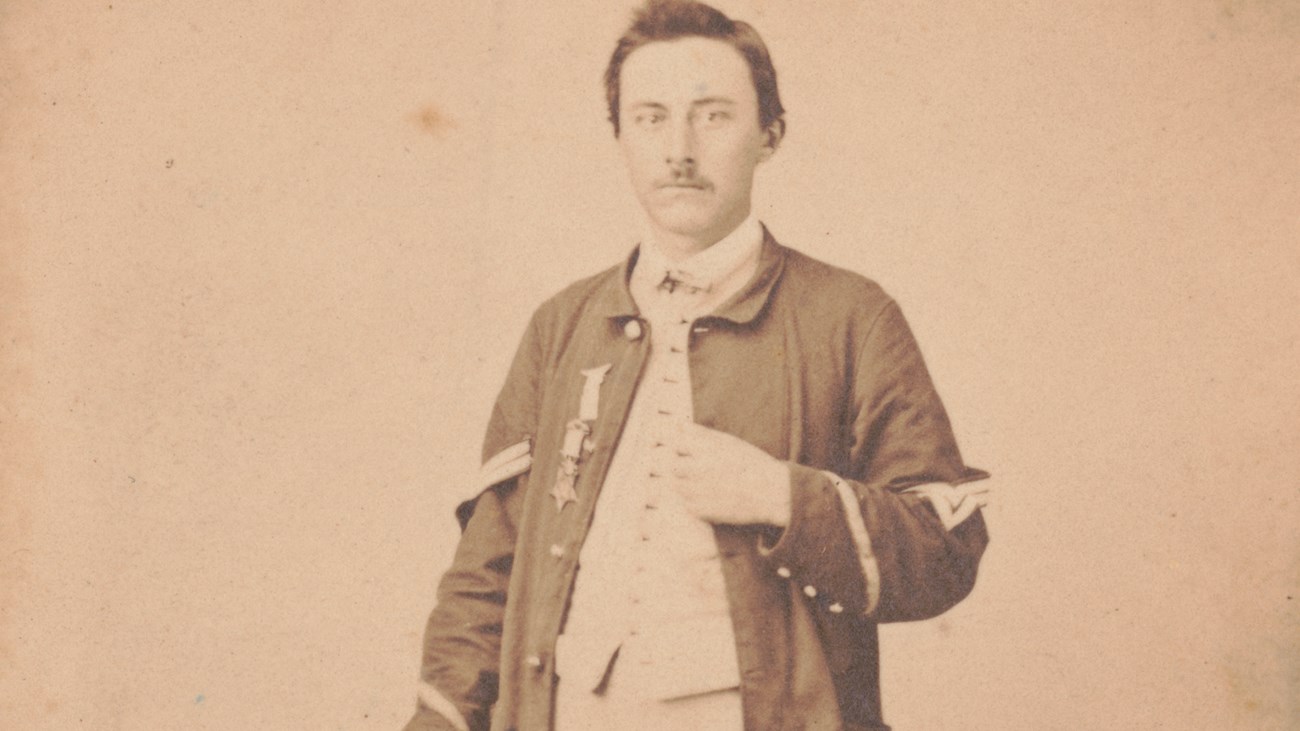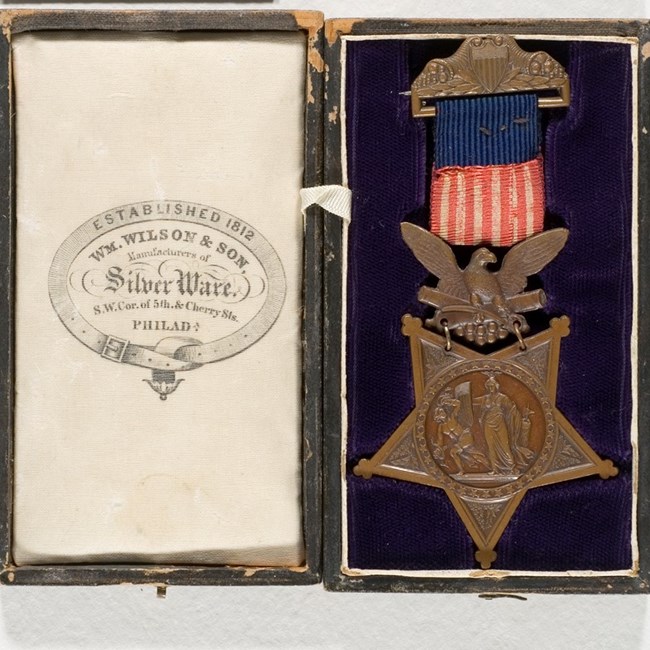Last updated: November 26, 2025
Article
Medal of Honor at Cedar Creek

Library of Congress
Twenty-one soldiers received the Medal of Honor for their actions at the battle of Cedar Creek. The United States created this medal in July 1862 for those who “distinguish themselves by their gallantry in action, and other soldier-like qualities,” and has since served as one of the nation’s top military honors. Several were presented many decades after the battle; others were awarded a mere week after the battle. Eleven medals were awarded for actions that involved the capture or recapture of regimental flags, while the other ten marked other heroic actions.
Cedar Creek and Belle Grove National Historical Park is a site on the Medal of Honor Valor Trail.

NPS/Gettysburg National Military Park
Daniel P. Reigle
One soldier who earned the medal on October 19, 1864 was Daniel P. Reigle of the 87th Pennsylvania Infantry. He enlisted in September 1861, earned the honor of becoming the regimental color bearer in September 1864, and was wounded in that role at Fisher’s Hill on September 22. A month later he had recovered from his wound and was serving at the battle of Cedar Creek on October 19. After being pushed back in the morning’s fight, Reigle and the 87th took part in the successful afternoon counterattack. The below document notes his actions during the attack.
CIRCULAR/ Headquarters, 3d Div., 6th AC, October 22, 1864/
The Colonel commanding the Division takes pleasure in announcing to the command that COLOR-SERGEANT DANIEL P. REIGLE, Co. F, 87th PV, has been ordered by Gen. SHERIDAN to report to Washington, DC for the purpose of having presented to him by the President of the U. States, a Medal of Honor for marked bravery displayed on the battle-field on the evening of the 19th inst. near Middletown, Va. and for gallantly rushing forward through a terrific fire and capturing a Rebel Flag at the stone fence where the enemy’s last stand was made.
COLOR-SERGEANT REIGLE will also be given, for these exhibitions of noble daring, a Furlough of 35 days, to enable him to visit his home.
It would be almost impossible to note each of the many brave deeds performed upon the field by the troops of this Division. The Colonel commanding tenders his thanks to the whole command for the very creditable manner in which they behaved during the engagement of the afternoon of the 19th inst.
By order of Colonel JW Keiffer./ ANDW. J. SMITH,/ Capt. And AAA Gen.
The mention of a “stone fence where the enemy’s last stand was made” likely indicates that Reigle’s action took place at the stone wall that ran along what is now modern Cougill Road. A native of Adams County, Reigle’s image, Medal of Honor, and circular describing his actions have returned home and are on display at Gettysburg National Military Park.
Medals of Honor Earned at Cedar Creek
|
Name |
Rank |
Unit |
Citation |
Date Awarded & Other Notes |
|---|---|---|---|---|
|
John W. Blunt |
1st Lieutenant |
6th New York Cavalry |
Voluntarily led a charge across a narrow bridge over the creek, against the lines of the enemy. |
June 1, 1908 |
|
Henry H. Crocker |
Captain |
2nd Massachusetts Cavalry |
Voluntarily led a charge, which resulted in the capture of 14 prisoners and in which he himself was wounded. |
January 10, 1896 |
|
Ulric L. Crocker |
Private |
6th Michigan Cavalry |
Capture of flag of 18th Georgia (C.S.A.). |
October 26, 1864 |
|
Captain |
5th US Artillery |
By his distinguished gallantry and voluntary exposure to the enemy's fire at a critical moment, when the Union line had been broken, encouraged his men to stand to their guns, checked the advance of the enemy and brought off most of his pieces. |
April 2, 1898 |
|
|
Edwin Goodrich |
1st Lieutenant |
9th New York Cavalry |
While the command was falling back, he returned and in the face of the enemy rescued a sergeant from under his fallen horse. |
May 14, 1894 |
|
William W. Henry |
Colonel |
10th US Infantry |
Though suffering from severe wounds, rejoined his regiment and led it in a brilliant charge, recapturing the guns of an abandoned battery. |
December 21, 1892 |
|
Ira Hough |
Private |
8th Indiana Infantry |
Capture of flag. |
October 26, 1864 |
|
George M. Love |
Colonel |
116th New York Infantry |
Capture of battle flag of 2d South Carolina (C.S.A.). |
March 6, 1865 |
|
Frederick Lyon |
Corporal |
1st Vermont Cavalry |
With one companion, (see James Sweeney) captured the flag of a Confederate regiment, three officers, and an ambulance with its mules and driver. |
October 26, 1864; One captured officer was Stephen Ramseur |
|
Andrew J. McGonnigle |
Captain |
Acting Chief Quartermaster |
While acting as chief quartermaster of Gen. Sheridan's forces operating in the Shenandoah Valley, McGonnigle was severely wounded while voluntarily leading a brigade of infantry and was commended for the greatest gallantry by Gen. Sheridan. |
July 21, 1897 |
|
Harry J. Parks |
Private |
9th New York Cavalry |
While alone and in advance of his unit and attempting to cut off the retreat of a supply wagon, he fought and sent to flight a Confederate color bearer. After capturing the color bearer and leaving him in the rear, he returned to the front and captured 3 more wagons and drivers. |
October 26, 1864; Awarded at age 16 |
|
Daniel P. Reigle |
Corporal |
87th Pennsylvania Infantry |
For gallantry while rushing forward to capture a Confederate flag at the stone fence where the enemy's last stand was made. |
October 26, 1864 |
|
David H. Scofield |
Quartermaster Sergeant |
5th New York Cavalry |
Capture of flag of 13th Virginia Infantry (C.S.A.). |
October 26, 1864 |
|
James Sweeney |
Private |
1st Vermont Cavalry |
With one companion (see Frederick Lyon) captured the state flag of a North Carolina regiment, together with three officers and an ambulance with its mules and driver. |
October 26, 1864; One captured officer was Stephen Ramseur; English immigrant |
|
Richard Taylor |
Private |
18th Indiana Infantry |
Capture of Flag. |
November 21, 1864 |
|
Stephen Thomas |
Colonel |
8th Vermont Infantry |
Distinguished conduct in a desperate hand-to-hand encounter, in which the advance of the enemy was checked. |
July 25, 1892 |
|
Amasa Tracy |
Lieutenant Colonel |
2nd Vermont Infantry |
Took command and led the brigade in the assault on the enemy's works. |
June 24, 1892 |
|
John Walsh |
Corporal |
5th New York Cavalry |
Recapture of the flag of the 15th New Jersey Infantry. |
October 26, 1864; Irish immigrant |
|
Martin Wambsgan |
Private |
90th New York Infantry |
While the enemy were in close proximity, this soldier sprang forward and bore off in safety the regimental colors, the color bearer having fallen on the field of battle. |
November 3, 1896; German immigrant |
|
Thomas M. Wells |
Chief Bugler |
6th New York Cavalry |
Capture of colors of 44th Georgia Infantry (C.S.A.). |
October 26, 1864; Irish immigrant |
|
Sergeant |
1st Vermont Cavalry |
During the regiment's charge when the enemy was in retreat, Sgt. Woodbury encountered four Confederate infantrymen retreating. He drew his saber and ordered them to surrender, overcoming by his determined actions their willingness to further resist. They surrendered to him together with their rifles and 12th North Carolina (C.S.A.) regimental flag. |
October 26, 1864 |
